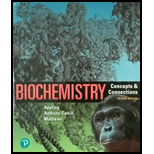
Concept explainers
(a) Interpretation:
Determination of whether the following intracellular concetration ratio will be 1, >1, or <1: a. [NAD+]/ [NADH].
Concept introduction:
The major electron donors required for reductive biosynthesis is nicotinamide adenine dinucleotide phosphate (NADPH). NADPH and NADP+ are similar to NADH and NAD+ respectively. The nicotinamide
(b) Interpretation:
Determination of whether the following intracellular concetration ratio will be 1, >1, or <1: b. [NADP+/[NADPH].
Concept introduction:
The major electron donors required for reductive biosynthesis is nicotinamide adenine dinucleotide phosphate (NADPH). NADPH and NADP+ are similar to NADH and NAD+ respectively. The nicotinamide nucleotide-linked enzymes which act in catabolic direction use NAD+/ NADH, whereas those which act in anabolic reactions uses NADP+/NADPH.
(c) Interpretation:
Determination of the process by which the concentration ratios might be maintained inside cells at greatly differing values since NAD+ and NADP+ are essentially equivalent in their tendency to attract electrons.
Concept introduction:
The major electron donors required for reductive biosynthesis is nicotinamide adenine dinucleotide phosphate (NADPH). NADPH and NADP+ are similar to NADH and NAD+ respectively. The nicotinamide nucleotide-linked enzymes which act in catabolic direction use NAD+/ NADH, whereas those which act in anabolic reactions uses NADP+/NADPH.
Trending nowThis is a popular solution!

Chapter 11 Solutions
Pearson eText for Biochemistry: Concepts and Connections -- Instant Access (Pearson+)
- Multiple choice urgent!!arrow_forward1. Write the transamination reaction for alanine. Indicate what happens next to each of the molecules in the reaction, and under what conditions it happens. 2.arrow_forwardCH3 17. Which one of the compounds below is the HNO3 H2 1. NaNO2, HCI Br₂ 1. LiAlH4 major organic product H2SO4 Ni 2. CuCN, KCN FeBr3 2. H₂O, H+ obtained from the following series of reactions? CH3 toluene CH3 CH3 Br Br Br CH3 CH3 && Br Br NH₂ A NH₂ NH₂ B C NH₂ ΝΗΣ D Earrow_forward
- 13. Which one of the compounds below is the major organic product obtained from the following series of reactions? A + H2C=CH-CO Me heat (CH3)2NH 1. LiAlH4 2. H₂O ? 1,3-butadiene OH 'N' B C 14. Which one of the compounds below is the major organic product obtained from the following series of reactions? 'N' D 'N' E 1. XS CH3I 'N' 2. Ag₂O 3. H₂O, A A B с D E Narrow_forwardA NH2 NH2 B C H₂N. NH₂ D 5. The five compounds above all have molecular weights close to 75 g/mol. Which one has the highest boiling point? 6. The five compounds above all have molecular weights close to 75 g/mol. Which one has the lowest boiling point? E NH₂arrow_forward7. A solution of aniline in diethyl ether is added to a separatory funnel. Which ONE of the following aqueous solutions will remove aniline from the ether layer (and transfer it to the aqueous layer) if it is added to the separatory funnel and the funnel is shaken? A) aqueous NH3 B) aqueous Na2CO3 C) aqueous HCl D) aqueous NaOH E) aqueous CH3COONa (sodium acetate)arrow_forward
- 11. Which of the following choices is the best reagent to use to perform the following conversion? A) 1. LiAlH4 2. H₂O B) HCI, H₂O D) NaOH, H₂O E) Na№3 ? 'N' 'N' C) 1. CH3MgBr 2. HCI, H₂Oarrow_forwardNH2 ΝΗΣ NH₂ NH2 NH2 A OCH3 NO₂ B C D E 1. Which one of the five compounds above is the strongest base? 2. Which one of the five compounds above is the second-strongest base? (That is, which one is next-to-strongest base?) 3. Which one of the five compounds above is the weakest base? 4. Which one of the five compounds above is the second-weakest base? (That is, which one is next-to-weakest base?) NO2arrow_forwardDraw a diagram to demonstrate 3' to 5' exonuclease activity?arrow_forward
- 1. Write the piece of mRNA that would code for the amino acid sequence NH3 - met - tyr - cys- his- CO2. Label the 5' and 3' ends. (diagram attached) 2.arrow_forwardYou were tasked with purifying an untagged transcription factor (molecular weight 65,000Da, isoelectric point unknown) from a contaminant Protein A (molecular weight 50,000 Da, isoelectric point 5.0). You were also instructed to use the protein for crystallization studies after purification.i) In the initial purification step, which type of chromatography should you attempt? Explain your choice and specify the requirements of the buffer solution you should use. ii) Analyzing the proteins recovered from step i) using SDS-PAGE, you still observed a faint band of Protein A in addition to the transcription factor band. Given the limited time available for further purification, you must choose ONE appropriate chromatography method to maximize the chances of separating the two proteins as well as your crystallization studies. Provide a detailed explanation of your selection and the techniques/strategies you would employ to achieve this.arrow_forwardYou were given a mixture of two proteins with different isoelectric points and molecular weights:• Protein X: pI 4.2, MW 42,000• Protein Y: pI 9.8, MW 90,000Using a Tris-glycine discontinuous native gel (pH8.3) electrophoresis system with a running gel of 12%, only a single band was observed upon protein staining after electrophoresis. Explain the observed result and discuss possible factors affecting protein migration in this system.arrow_forward
 BiochemistryBiochemistryISBN:9781319114671Author:Lubert Stryer, Jeremy M. Berg, John L. Tymoczko, Gregory J. Gatto Jr.Publisher:W. H. Freeman
BiochemistryBiochemistryISBN:9781319114671Author:Lubert Stryer, Jeremy M. Berg, John L. Tymoczko, Gregory J. Gatto Jr.Publisher:W. H. Freeman Lehninger Principles of BiochemistryBiochemistryISBN:9781464126116Author:David L. Nelson, Michael M. CoxPublisher:W. H. Freeman
Lehninger Principles of BiochemistryBiochemistryISBN:9781464126116Author:David L. Nelson, Michael M. CoxPublisher:W. H. Freeman Fundamentals of Biochemistry: Life at the Molecul...BiochemistryISBN:9781118918401Author:Donald Voet, Judith G. Voet, Charlotte W. PrattPublisher:WILEY
Fundamentals of Biochemistry: Life at the Molecul...BiochemistryISBN:9781118918401Author:Donald Voet, Judith G. Voet, Charlotte W. PrattPublisher:WILEY BiochemistryBiochemistryISBN:9781305961135Author:Mary K. Campbell, Shawn O. Farrell, Owen M. McDougalPublisher:Cengage Learning
BiochemistryBiochemistryISBN:9781305961135Author:Mary K. Campbell, Shawn O. Farrell, Owen M. McDougalPublisher:Cengage Learning BiochemistryBiochemistryISBN:9781305577206Author:Reginald H. Garrett, Charles M. GrishamPublisher:Cengage Learning
BiochemistryBiochemistryISBN:9781305577206Author:Reginald H. Garrett, Charles M. GrishamPublisher:Cengage Learning Fundamentals of General, Organic, and Biological ...BiochemistryISBN:9780134015187Author:John E. McMurry, David S. Ballantine, Carl A. Hoeger, Virginia E. PetersonPublisher:PEARSON
Fundamentals of General, Organic, and Biological ...BiochemistryISBN:9780134015187Author:John E. McMurry, David S. Ballantine, Carl A. Hoeger, Virginia E. PetersonPublisher:PEARSON





